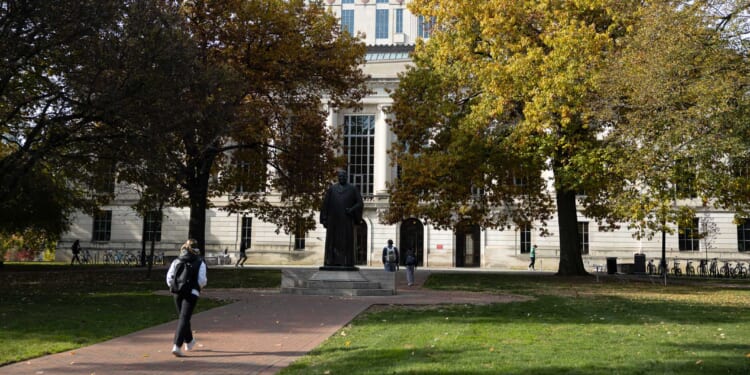
In 2021, at the height of the diversity, equity, and inclusion movement, Ohio State University’s then-president Kristina Johnson announced a bold initiative: the university would hire 50 professors whose scholarship addressed “social equity and racial disparities” and seek to recruit “100 underrepresented and BIPOC [black, indigenous, and people of color] hires in all fields of scholarship.”
Overnight, Ohio’s flagship university became one of the country’s leading DEI champions. Today, it’s still dealing with the consequences. Newly acquired records provide an inside look at the initiative and how it shaped the university’s research agenda. In one hiring cycle, 60 percent of new faculty roles in the arts and humanities focused on race, social justice, or diversity.
Finally, a reason to check your email.
Sign up for our free newsletter today.
Administrators kept tabs on the hiring spree to ensure compliance with the university’s DEI goals. In one email exchange from November 2022, Korie Little Edwards, interim diversity dean, told Dana Renga, dean of arts and humanities, that she wanted to meet with the finalist candidates for an assistant professor position in “indigenous knowledges.” This professor, per the job’s advertisement, would specialize in “the intersections between race, Indigeneity, and education.” Given the role’s focus, Edwards saw fit to insert herself in the process.
“This is an appropriate job search for me to meet with candidates, given the DEI central aims of the position,” the diversity officer wrote to Renga.
But meeting with all DEI-themed jobs’ finalists proved unworkable because too many jobs fit that description. In fact, 60 percent of the new arts and humanities faculty roles had similar thematic emphases.
“I am totally fine with this,” Renga wrote in response to Edwards. “Only consideration is that 23 out of the 38 A&H hires place a focus on DEI / social and racial justice.”
With trust in higher education at a low point, even many insiders have called attention to the lack of viewpoint diversity among faculty. Many Americans are well aware that academia prioritizes a narrow set of progressive social and political views.
The candid exchange at Ohio State shows how this phenomenon arose—not organically, but through a concerted effort to boost the number of progressive scholar-activists.
Job listings show the extent of Ohio State’s commitment to DEI. At about the same time the university sought to hire a scholar of “indigenous knowledges,” the anthropology department advertised a position for an archaeologist who emphasized “decolonization, feminist theory, queer theory, critical race theory, and/or Indigenous ontologies.” The philosophy department called for a professor of “philosophy of race” to explore the “metaphysics of race” and “epistemological significance of race or racism.”
Who was recruited for the DEI-focused roles? Other documents list the candidates, revealing hiring practices both overtly ideological and, at times, comical.
One of those documents, a search committee’s recruitment report, described the finalists for a role as scholar who researches the “intersections of race, science and technology studies (STS), and public health.” In the report, the search committee emphasized that diversity, equity, and inclusion would be paramount considerations as it made the new hire. The committee’s finalists showed what they had in mind. The report observed that one of those candidates “examines the racialization of fatness and its linkages to histories of health, nation, and empire.” Another explores how “NASA’s Mars Exploration Program rovers represent ‘autonomous colonial laboratories.’”
The search committee touted these candidates’ progressive bona fides—and their demographic characteristics. One candidate, the committee noted, was “a disabled scholar and queer woman of color.” Another “interrogate[s] how fatphobia and ableism are institutionalized in public infrastructure through race science, gender oppression, and legacies of colonialism.” That candidate “identifies as ‘a first generation, fat, queer scholar of color.’”
When delivering the records to me, Ohio State spokesman Benjamin Johnson pointed out that the university had eliminated Edwards’s diversity officer position. He said that the university’s hiring policies have been modified to “align with Ohio Senate Bill 1, which took effect in June 2025 and includes broad prohibitions on DEI.”
But these records reveal how deeply the ideology was embedded at Ohio State. The university’s previous leaders—many remaining in important positions—sought to transform the institution through a large-scale personnel project. Its new leadership will need to show commitment and vigilance to turn the tide.
Photo by MEGAN JELINGER/AFP via Getty Images
City Journal is a publication of the Manhattan Institute for Policy Research (MI), a leading free-market think tank. Are you interested in supporting the magazine? As a 501(c)(3) nonprofit, donations in support of MI and City Journal are fully tax-deductible as provided by law (EIN #13-2912529).
Source link

















